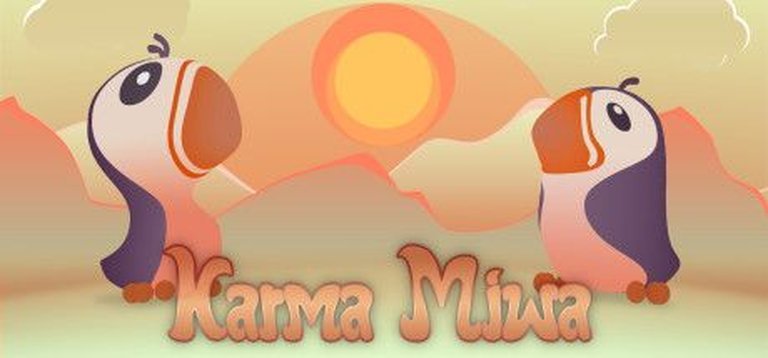- Release Year: 2016
- Platforms: Windows
- Publisher: OtakuMaker.com
- Developer: Alan Ishøj Bostrup-Sørensen (aka Space Fractal)
- Genre: Action
- Perspective: Side view
- Game Mode: Single-player
- Gameplay: Platform
- Setting: Fantasy
- Average Score: 70/100

Description
Karma Miwa is a 2D side-scrolling platformer where players control a flightless bird named Miwa on a perilous journey home to its mate. Inspired by classic games like Snokie, the bird must navigate through 21 levels filled with enemies and obstacles, utilizing precise jumps and avoiding hazards. The game features two playable characters with different speeds and difficulty modes, enhanced graphics, and a challenging ‘Pro Mode’ for experienced players.
Gameplay Videos
Where to Buy Karma Miwa
PC
Karma Miwa Cracks & Fixes
Karma Miwa: Review
Introduction
Karma Miwa is an ode to classic platformers, offering a unique blend of retro charm and modern sensibilities. The game tells the story of two flightless birds, Terry and Miwa, separated and navigating treacherous environments to reunite. With its roots in the 1980s classic Snokie, Karma Miwa captivates with its inventive mechanics and atmospheric presentation, Stoically asserting its place in the platformer canon.
Development History & Context
The game hails from developer Space Fractal and publisher OtakuMaker.com, born out of the indie boom that revitalized platformers with fresh perspectives. The small team, including key contributors like Kasper Rubin (2D backgrounds) and Erico Patricio Monteiro (3D sprites), pooled their talents to create an experience that pays homage to gaming’s past while forging its own path. Released in 2016, Karma Miwa entered a market teeming with indie platformers, yet managed to stand out through its unique gameplay and visual style.
Narrative & Thematic Deep Dive
The narrative is straightforward yet compelling. Terry and Miwa, for unknown reasons, have become separated. Their journey home is fraught with danger, drawing players into a tale of perseverance and resilience. The underlying theme of finding one’s way home against all odds resonates strongly. The two-hit system introduces a deeper layer of strategy, where initial contact isn’t fatal, encouraging calculated risks and skill improvement.
Characters are minimal but distinct, each with their own playstyles (Terry is faster, Miwa slower) and two difficulty modes apiece. The environments are rich with detail, each area presenting unique challenges that test players’ mettle. Enemies are diverse, ranging from piranhas to birds with stones, each requiring a different approach.
Gameplay Mechanics & Systems
At the core of Karma Miwa’s gameplay is its innovative jumping system. Players control their bird’s movement and three jump types: left, right, and normal. This mechanical depth requires precision timing and spatial awareness. The inability to control jumps mid-air or on slopes adds a layer of challenge, forcing players to plan moves carefully. The two-hit system provides a buffer, but also adds tension with each near-miss.
Level design is expertly crafted, with 21 levels spread across three environments. Each level introduces new obstacles and enemies, maintaining a sense of progression. Difficulty modes range from casual to pro, making the game accessible while offering hardcore challenges. The practice mode after losing all lives is a thoughtful inclusion, allowing players to continue tackling levels at their pace.
World-Building, Art & Sound
The artistic direction masterfully combines retro aesthetics with modern flourishes. Kasper Rubin’s 2D backgrounds are vibrant and atmospheric, while Erico Patricio Monteiro’s 3D sprites bring the characters and enemies to life. This visual synergy creates a cohesive and engaging world that immerses players. The soundtrack by Jesse Ratterree (Beatscribe) complements the gameplay, with catchy tunes that enhance the platforming experience.
Reception & Legacy
Karma Miwa received mixed reviews at launch but has since carved a niche among platformer enthusiasts. Users laud its challenging gameplay, retro charm, and atmospheric presentation. Others found the controls restrictive or the difficulty too high. This dichotomy reflects the game’s bold design choices, which prioritized authentic retro gameplay over modern accessibility features. Its influence can be seen in other indie platformers that embrace similar mechanics or art styles.
Conclusion
Karma Miwa stands as a testament to the power of indie development, merging old-school platforming with modern sensibilities. Its unique mechanics, rich world-building, and thematic depth make it a must-play for genre fans and casual gamers alike. While challenging, the game offers ample rewards for those who persist, cementing its place in video game history as a singular and accomplished platformer.